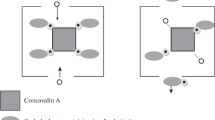Abstract
The thromboresistance of glucose-sensitive polymer hydrogels, modeling one of the functions of the pancreas, namely, the ability to secrete insulin in response to the introduction of glucose into the environment, has been studied. Hydrogels were synthesized by the copolymerization of hydroxyethyl methacrylate with N-acryloyl glucosamine in the presence of a cross-linking agent and subsequently treated with concanavalin A. Introduction of glucose residues into the hydrogel did not result in significant changes in either the number of trombocytes adhered to the hydrogel or the degree of denaturation of blood plasma proteins interacting with the hydrogel. Consequently, the biological activity of insulin did not change after release from the hydrogel. The use of glucose-sensitive hydrogels is supposed to contribute to the development of a novel strategy for the treatment of diabetes.
Similar content being viewed by others
References
Kashyap, N., Viswanad, B., Sharma, G., Bhardwaj, V., Ramarao, P., and Ravi, Kumar M.N., Biomaterials, 2007, vol. 28, no. 11, pp. 2051–2060.
Valuev, I.L., Chupov, V.V., Sytov, G.A., Valuev, L.I., and Plate, N.A., Vysokomol. Soedin. B, 1997, vol. 39, no. 4, pp. 751–754.
Valuev, I.L., Vanchugova, L.V., and Valuev, L.I., Vysokomol. Soedin. A, 2011, vol. 53, no. 5, pp. 691–695.
Ivakura, Y., Imai, Y., and Vagu, Y., J. Polym. Sci. A-1, 1968, vol. 6, no. 6, p. 1625.
Biosovmestimost’ (Biocompatibility), Sevast’yanov, V.I., Ed., Moscow: Inform. Tsentr Nauchno-Issled. Inst. Geosist., 1999.
Kim, S.W., Lee, R.D., Coleman, D., Oster, H., Andrade, J.D., and Olsen, D.B., Trans. Am. Soc. Art. Int. Org., 1974, vol. 20, pp. 449–454.
Jorgensen, K.A. and Stoffersen, E., Thromb. Res., 1980, vol. 17, pp. 13–18.
Jamieson, G.A., Birth Defects Orig. Artic Ser., 1973, vol. 9, no. 2, pp. 202–205.
Jamieson, G.A., Smith, D.F., and Kosow, D.P., Thromb. Diath. Haemorrh., 1975, vol. 33, no. 3, pp. 668–671.
Smith, D.F., Kosow, D.P., and Jamieson, G.A., Thromb. Diath. Haemorrh., 1975, vol. 34, no. 1, pp. 334–337.
Author information
Authors and Affiliations
Corresponding author
Additional information
Original Russian Text © I.L. Valuev, L.I. Valuev, L.V. Vanchugova, I.V. Obydennova, T.A. Valueva, 2013, published in Prikladnaya Biokhimiya i Mikrobiologiya, 2013, Vol. 49, No. 3, pp. 319–321.
Rights and permissions
About this article
Cite this article
Valuev, I.L., Valuev, L.I., Vanchugova, L.V. et al. Thromboresistance of glucose-containing hydrogels. Appl Biochem Microbiol 49, 312–314 (2013). https://doi.org/10.1134/S0003683813030162
Received:
Published:
Issue Date:
DOI: https://doi.org/10.1134/S0003683813030162




